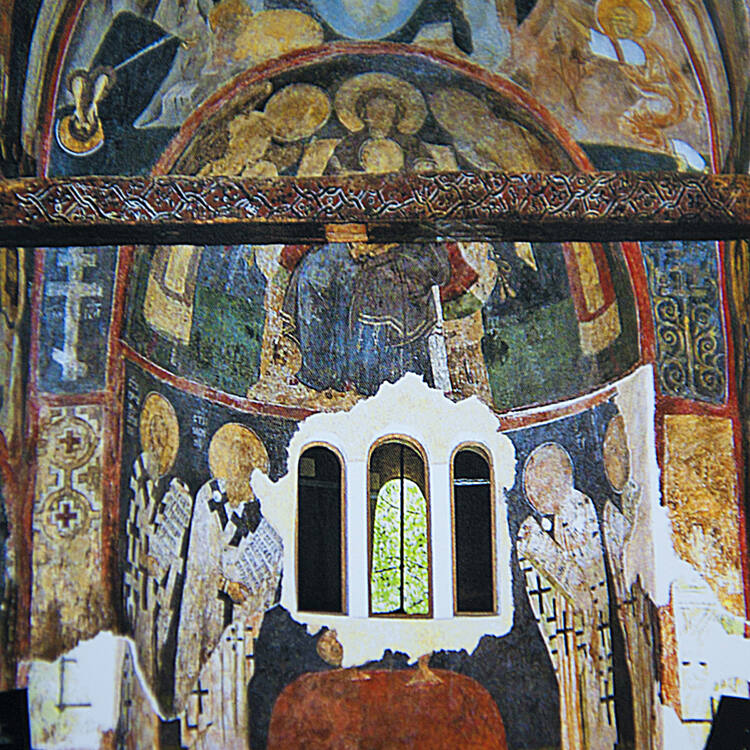Boyana Church
Boyana Church
Located on the outskirts of Sofia, Boyana Church consists of three buildings. The eastern church was built in the 10th century, then enlarged at the beginning of the 13th century by Sebastocrator Kaloyan, who ordered a second two storey building to be erected next to it. The frescoes in this second church, painted in 1259, make it one of the most important collections of medieval paintings. The ensemble is completed by a third church, built at the beginning of the 19th century. This site is one of the most complete and perfectly preserved monuments of east European medieval art.
Description is available under license CC-BY-SA IGO 3.0
Église de Boyana
Située à la périphérie de Sofia, l’église de Boyana se compose de trois bâtiments. L’église de l’Est a été construite au Xe siècle. Au milieu du XIIIe siècle, Sebastocrator Kaloyan a agrandi l’église et a demandé que l’on construise un second bâtiment de deux étages à côté de l’ancien. Ses fresques, peintes en 1259, constituent l’une des plus importantes collections de peintures médiévales. L’ensemble est complété par une troisième église, édifiée au début du XIXe siècle. Ce site comprend les monuments les plus parfaits et les mieux conservés de l’art médiéval d’Europe de l’Est.
Description is available under license CC-BY-SA IGO 3.0
كنيسة بويانا
تتألف كنيسة بويانا الواقعة في محيط العاصمة صوفيا من ثلاثة أبنية أساسية. شُيّدت الكنيسة الشرقية في القرن العاشر وفي منتصف القرن الثالث عشر، وسّع سيباستوكراطور كالويان الكنيسة وطلب تشييد بناء ثان من طبقتين بالقرب من المبنى القديم. وتشكّل جدرانيات هذه الكنيسة التي رُسمت في العام 1259 إحدى أهم المجموعات الفنية في القرون الوسطى. واستُكمل هذا البناء الضخم بكنيسة ثالثة في مطلع القرن التاسع عشر. يحوي هذا الموقع على أحد أجمل النصب وأفضلها حالاً من الفن الخاص بالقرون الوسطى في أوروبا الشرقية.
source: UNESCO/CPE
Description is available under license CC-BY-SA IGO 3.0
博雅纳教堂
博雅纳教堂位于索菲亚城郊外,由三座建筑物组成。东侧的教堂最初建于公元10世纪,后于公元13世纪初由卡洛扬大总督指挥扩建。卡洛扬大总督还决定在东侧教堂旁再建一座双层教堂。第二个教堂里有绘于公元1259年的壁画,这些艺术品使该世界遗产成为了最重要的中世纪绘画收藏地之一。第三座教堂建于19世纪初,最终构成了一个完整的教堂群。该遗产是最完整、保存最完好的建筑之一,体现了东欧中世纪的艺术风格。
source: UNESCO/CPE
Description is available under license CC-BY-SA IGO 3.0
Боянская церковь (София)
Расположенный в предместьях Софии, ансамбль Боянской церкви состоит из трех зданий. Восточная церковь была построена в X в.и расширена в начале XIII в. царем Калояном, который приказал возвести рядом и второе двухэтажное здание. Фрески этой второй церкви, выполненные в 1259 г., являются одним из наиболее значительных собраний средневековой живописи. Ансамбль завершает третья церковь, построенная в начале XIX в. Весь этот объект наследия представляет собой один из наиболее полных и великолепно сохранившихся памятников средневекового искусства на востоке Европы.
source: UNESCO/CPE
Description is available under license CC-BY-SA IGO 3.0
Iglesia de Boyana
Emplazada en las afueras de Sofía, la iglesia de Boyana comprende tres edificios. La iglesia de la parte oriental, fue construida en el siglo X. A mediados del siglo XIII, el sebastocrator Kaloyan ordenó que se agrandara la iglesia primigenia y se construyese otra de dos plantas junto a ella. Los frescos de esta segunda iglesia, pintados en 1259, constituyen uno de los mí¡s valiosos conjuntos de la pintura medieval. A comienzos del siglo XIX se edificó una tercera iglesia, ultimí¡ndose así la configuración definitiva del sitio, que es uno de los monumentos mí¡s completos y mejor conservados del arte medieval de Europa Oriental.
source: UNESCO/CPE
Description is available under license CC-BY-SA IGO 3.0
ボヤナ教会
source: NFUAJ
Boyana kerk
Source: unesco.nl
Outstanding Universal Value
Brief synthesis
There are several layers of wall paintings in the interior from the 11th, 13th, 15-17th and 19th centuries which testify to the high level of wall painting during the different periods. The paintings with the most outstanding artistic value are those from 13th century. Whilst they interpret the Byzantine canon, the images have a special spiritual expressiveness and vitality and are painted in harmonious proportions.
Criterion (ii): From an architectural point of view, Boyana Church is a pure example of a church with a Greek cross ground-plan with dome, richly decorated facades and decoration of ceramic elements. It is one of the most remarkable medieval monuments with especially fine wall paintings.
Criterion (iii): The Boyana Church is composed of three parts, each built at a different period - 10 century, 13th century and 19th century which constitute a homogenous whole.
Integrity
The integrity of Boyana church is fully assured. In 1917 a park was created around the church, thereby securing its immediate surroundings through being separated from the impact of modern traffic. The property has also remained intact from historic invasions, and other destructive threats. Three separate zones are defined in the property boundaries and buffer zone, through which appropriate control measures are applied.
Authenticity
The concept, form and development of the three constructional phases of the property, from the 10th-11th; 13th; and 19th centuries, are clearly evident. Necessary conservation and restoration works have been completed. Where sufficient evidence existed, later façade renders have been removed to reveal the original appearance of walls.
To safeguard and present the internal 11th and 12th centuries fresco fragments, those from the 13th century, and the later 1882 additions in the antechamber, they were cleaned, refilled and conserved. This work was completed in 2008. The property is now air-conditioned, and under constant surveillance.
Protection and management requirements
The management is implemented by virtue of:
- Cultural Heritage Law (Official Gazette No 19 of 2009) and subdelegated legislation. This law regulates the research, studying, protection and promotion of the immovable cultural heritage in Bulgaria, and the development of Conservation and Management plans for its inscribed World Heritage List of immovable cultural properties.
- Instructions on the Protection and Preservation of the World Monument "Boyana Church" and its Protective Zone were adopted by Official Cover Letter No.RD-91-00-17, signed by the Chairman of the Culture Committee, and dated 10.08.1989. These Instructions are mandatory and set out the responsibilities of the interested parties, including the state, local institutions and owners.
